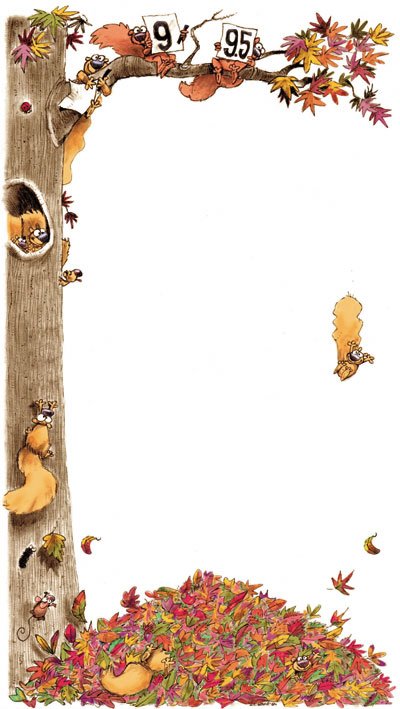There is something about a pile of fall leaves that is
irresistible: A sunny fall day with just the right chill in the
air. You take that long lunch in the park, and there they are. A
jumble of red, gold and orange leaves. Calling to you.
”
Come run through me, toss my golden bounty in the air.
”
There is something about a pile of fall leaves that is irresistible: A sunny fall day with just the right chill in the air. You take that long lunch in the park, and there they are. A jumble of red, gold and orange leaves. Calling to you. “Come run through me, toss my golden bounty in the air.”
“Dive in and roll around. … You know you want to.”
But you resist the siren song. After all, you’re an adult, and leaf diving is for kids, right?
Silly rabbit.
We say the fun of jumping into leaves is for everyone. So allow us to reintroduce the older ones and initiate youngsters to the fine art of leaf diving.
PICKING THE PILE
There are a couple of things to remember when selecting the perfect pile of leaves for diving: depth and density.
Too shallow, and people could get hurt; too deep, and you might never get through them.
Our highly unscientific research reveals that the ideal pile is at least 3 feet tall at the center and twice as wide. Yes, it’s a load of leaves, but you only get to do this a couple of times a year, so do it right.
As for density, kick through the leaves a little to loosen the pile. Tightly packed leaves are no good.
Also, take note of where the pile is. Grass is best. If the leaves are anywhere near a street, think twice. Curbs are the hidden dangers of leaf piles (as some of us have found out the hard way – the really hard way). There is nothing like a belly flop onto concrete to make you hate autumn.
Stay away from leaves that look the slightest bit wet, and watch out for sticks. And, most importantly, avoid leaves that are floating in water.
WHAT TO WEAR
Note: Fashion tips depend on crisp temperatures. Adjust accordingly.
We’re talking about diving into leaves here, not running the Joan Rivers gantlet at the Oscars, so really, you’re free to come as you are.
But in the ideal leaf-diving universe, there are a few things you might want to consider.
First off, LEAVES CAN SCRATCH. You’ll no doubt come into contact with the occasional branch or twig, so gloves are a good bet, and – especially if you’ve got a head of hair on ya – a cap.
Also, diving through the air in a barn jacket might seem nice and rustic and Martha Stewart-ish, but think about it: You’ll be plucking leaves out of the pockets through March.
The same warning goes for clothes that are too loose – baggy hip-hop jeans could mean days of picking leaves out of your nether regions.
Instead, we recommend a cotton turtleneck (impenetrable to leaves) underneath a cozy old wool sweater.
And again, depending on how brisk it is, we recommend long johns underneath a pair of sturdy jeans. Extra padding could be good. You know. Curbs.
STYLE and TECHNIQUE
You have your pile and your gear, so what’s next?
If you are 5, do what comes naturally. If you are several decades older, watch a 5-year-old first. Leaf diving is about letting go and reveling in nature.
Feeling a little cautious? Start slowly with a solid jump right into the middle – feet or bottom first, your pick. Once you are waist-high in leaves, you’ll loosen up.
Wanna dive full force into nature? Try a Nestea plunge and just fall back into a pile of autumn goodness. (But remember depth and density – see “Picking the Pile” – we don’t want anybody with a busted noggin.)
Once you’ve dived into the leaf pile, what then?
Toss a few handfuls of leaves in the air and then make sure to prepare the pile for the next person.
PRESERVING LEAVES
The colors of autumn don’t have to disappear with the onset of winter. There are a variety of ways to preserve leaves that can lock in the fall beauty for several weeks or more.
Traditional wax paper method
– Place leaves between two layers of wax paper.
– Cover with an old towel.
– Press the fabric with a warm iron for about 30 seconds. This should seal the leaf in the wax paper.
– After, cut the leaves out from the two pressed wax paper sheets. But leave a narrow margin of wax paper around the leaf edge. Children should never preserve leaves with wax paper without parental supervision.
Microwave oven method
– Pick fresh, colorful leaves from trees. Don’t use leaves that have fallen already.
– Place the leaves separately on two paper towel sheets in the microwave oven, and cover them with another sheet of paper towel.
– Run the oven for 30 to 180 seconds. Drier leaves require less time. Baking leaves in the microwave for more than three minutes could create a fire hazard. Leaves that curl following time in the microwave have not dried enough.
– Allow leaves to dry for one or two days. Then apply a sealant, such as an acrylic craft spray, to the leaves.
Glycerin and water method
– Submerge leaves in a pan filled with a solution of one part glycerin and two parts water.
– Let leaves soak in the solution for two to six days. Remove the leaves and wipe off the excess liquid.
Did you know?
The International Society of Arboriculture says a couple of key factors can determine whether fall foliage colors explode in brilliance or produce a muted palette.
Favorable Conditions
– Fertile soil enhances the intensity of reds in leaves.
– The more sunlight a leaf receives, the more likely it is to turn red.
– Warm sunny days followed by cool nights with temperatures below 45 degrees create the most favorable conditions for strong color.
Unfavorable Conditions
– Rainy or cloudy days near “peak coloration time” limit photosynthesis and dampen the vividness of autumn color.
– Freezing temperatures and heavy frost can significantly reduce autumn color intensity by damaging leaves before pigments are fully developed.












